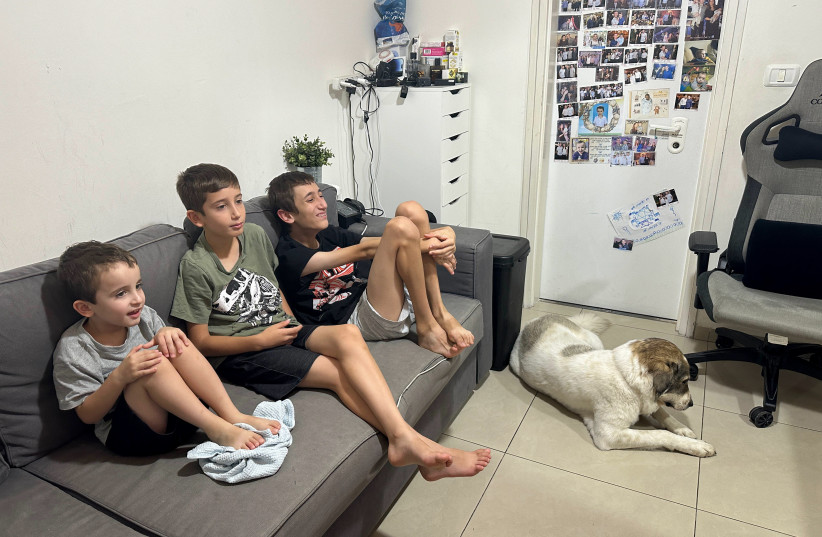Your worry, anxiety, sadness, trauma, anger, and confusion is normal at this time, and so is your child’s.
Our children look to us to help them make sense of what’s happening and for a sense of safety.
The tragic events of the past few days and going forward impact our physical and mental well-being.
Children may become increasingly clingy, act out, or even appear to be ambivalent. Signs of anxiety could include a pounding heart, restlessness, sleeplessness, shortness of breath, irritability, stomach pains, headaches, shaking, and sometimes just a feeling that things are not right. When we are traumatized, our thoughts, memories, and images could freeze in time and replay over and over again.
You can explain to your children that these reactions are natural when our fight-flight response is triggered by a perceived threat. They serve as a helpful warning and could even give us the extra energy to run to safe rooms or even fight. But when we cannot directly fight or run when triggered, we need to find other ways to manage our response in order to help our minds and bodies continue to function.
As the violence continues, being overwhelmed will make it more difficult for us to help our children process and manage their feelings. Preschoolers need emotional containment from the adults around them. School-age children are only just learning to self-regulate, with adult support.
It is not necessary to hide your emotions completely for your child’s well-being, but they need to know that the adults around them are doing all they can to keep them safe. This is particularly hard for those of us who have not had that sense of containment from own parents during childhood or who have experienced previous traumas. If overwhelmed, a good suggestion is to identify another trusted adult who could talk to your children about what is happening.
A child’s age, sensitivity, and maturity are significant, and as a parent, you can judge how much information your child is capable of managing. A helpful technique is to have the children lead the process, allowing them to ask the questions or ascertaining what they know already – what they have heard in the playground, from the news, at school – and to go from there. A nervous child might have been exposed to an earlier trauma, in which case the current situation could be a serious trigger.
GIVE CONCRETE and factual explanations when possible about what’s happening and the countries that are working together to restore peace and safety; emphasize that most people are good. During conversations, try to display optimism and hope. Older children might be able to discuss in greater detail the developments regarding international efforts to end the fighting and broker an agreement.
It’s helpful to keep the conversation open, and sometimes this is easier to achieve when you are involved in another activity together, such as baking or traveling in a car.
Always validate and never underestimate their feelings. For example, avoid responding with comments such as “that’s silly,” “that won’t happen,” or “stop saying that.” You want them to feel comfortable sharing their thoughts without fear of being judged or shut down. The message to relay is that there are no right and wrong feelings to express, that all their reactions are valid, and that it’s safe to communicate and manage their emotions with you.
Be available to them, remind them that their safety is your priority, and suggest other people with whom they might want to speak. Tell them which adults in the vicinity are helping to protect them and explain how.
TRY TO check in and help them express what thoughts are running through their minds. Here are some suggestions, from a cognitive behavior therapy approach, on what to ask:• What’s running through your mind when you see/hear that?• What worries you when you see/ hear x?• What feelings arise when you think about x?• Many people are talking about x; how do you feel about it?• What have you seen online? How does it make you feel?• Do you feel any physical change when you think about x?
Also, you could draw an outline of a body and have them (and you) mark where they notice those feelings.
If they are unable to share their thoughts and feelings easily, perhaps they can they do it through play/drawing/dancing? Can they relate to a scale from 0-100 of an energy battery to show how their level of anxiety at particular times?
Once you gain an understanding of some of their difficult feelings, you can help them process their thoughts. Explain how you and other adults around them are keeping them safe.
ACT ACCORDING to your values (ideas from Acceptance and Commitment Therapy, ACT):
Watching the news over and over again is not helpful. Instead, try to take a ‘committed action’ that coincides with your values during some of the time.
Some suggestions are raising funds to help others in need, particularly at this time, and donating to similar causes; reaching out to friends and family members; showing kindness to others; joining campaigns, and writing letters. Helping others also provides a sense of calm and well-being.
These efforts could also be a useful distraction. It isn’t healthy to be focused on the media 24/7; we need breaks. Find nurturing and fun activities, such as puzzles, games, songs, writing poems/letters together, and reading together.
HERE ARE some coping tools.
‘Grounding’ means coming back to the present moment rather than playing our worries in our heads over and over again. While the present moment may not be very pleasant, we can focus on the people we know and love who are with us, support us and give hope for the future.
As long as it’s safe to do so (and the sounds, sights and smells aren’t currently distressing), you might try identifying the following:•• 5 things you can see,• 4 things you can hear,• 3 things you can smell,• 2 things you can touch or taste, or• 5 things you can see in the room.
Deep diaphragmatic breathing can bring us back to ourselves. When all else fails, we have our breath to ground and center us. If someone is distressed and entering ‘freeze’ mode, it’s important to get them moving. Small movements such as wiggling feet, legs, arms, and hands as well as tensing and relaxing different muscle groups may be a helpful start.
Perhaps there are some reassuring words/affirmations you could use while holding them close, such as:• “I am loved,”• “X is looking after me,”• “I am safe right now,”• “This situation can make me stronger,”•“I am not alone,” and•“I choose to shine”
Give and receive extra nurturing than usual at this time – this can be done by, for example, watching films/TV shows together, cuddling, walking, gaming, or reading together. Reassure your children that you are always there to help them; offer them hugs, talk, or distraction – find what works best for them.
If they go back to school, find ways to help them stay connected. Give them something from you to keep with them throughout the day and remind them that they are loved. If they have phones, check in to see how they are doing.
FINALLY, PLEASE limit exposure. Be mindful of what you talk about, your tone of voice, and your own distress as well as the news that’s on the radio/TV. For example, your children might hear something worrying on the news. There may be harrowing images and sounds that are traumatizing
Be extremely mindful of social media – many unfiltered videos are being shared now, and this will likely continue in the coming days. Share information regularly through conversation instead. Children’s brains cannot manage the negative news. We need to help them to process their emotions and not feel overwhelmed. Bad things are happening, but good people are trying to make it better.
All the same applies to you. Please take care of yourselves.
The writer is a chartered child and adolescent specialist clinical psychologist and associate fellow of the British Psychological Society. She is a co-founder of the Israeli charity Jeremy’s Circle and works as a child and adolescent clinical psychologist at the Gesher Assessment Centre in NW London.

